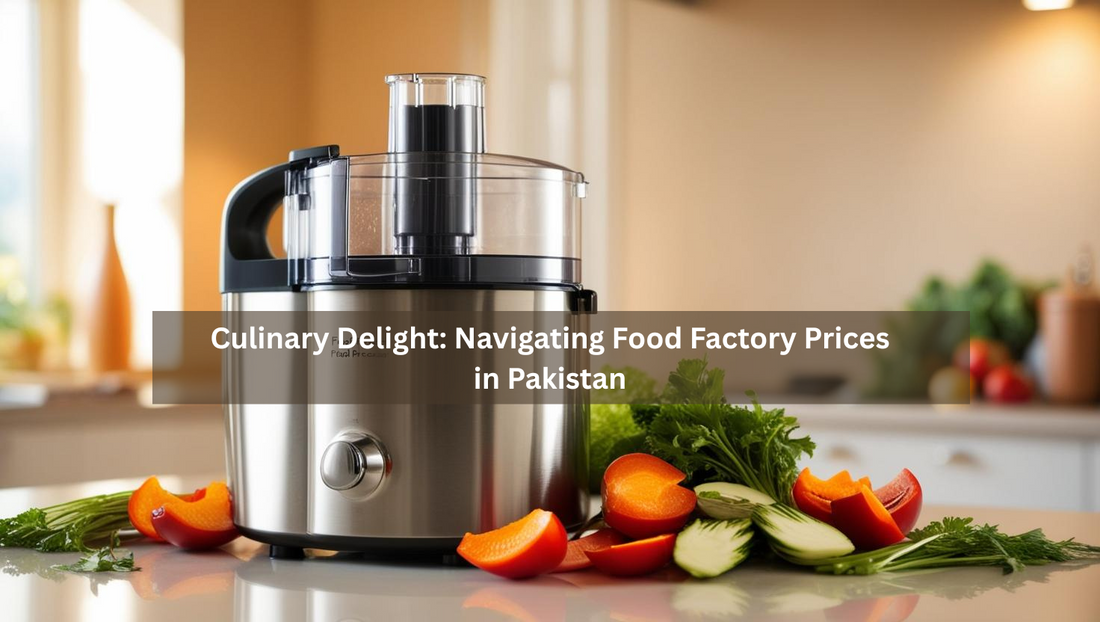
In today’s vibrant culinary world, food manufacturing stands at the crossroads of creativity and commerce. Food factories have evolved into modern hubs where tradition meets innovation, ensuring that quality ingredients reach our tables. As you explore the array of products and services offered by these facilities, understanding Food Factory Prices in Pakistan becomes essential for both consumers and business owners alike.
This blog post will guide you through the complex landscape of food factory pricing, provide practical insights, and help you make well-informed decisions in a market that is as dynamic as it is exciting.
Throughout this guide, we celebrate the essence of culinary delight while addressing the factors that influence the cost of production in Pakistan. Our humanistic approach focuses on the stories behind the numbers, the artisanal passion that drives food production, and how these elements are reflected in Food Factory Prices in Pakistan.
Let us take you on a journey that uncovers the inner workings of modern food manufacturing and helps you navigate the market with confidence.
Understanding the Food Factory Landscape
The Evolution of Food Manufacturing
Food manufacturing in Pakistan has undergone a significant transformation over the years. Traditional methods, once relied upon to process small quantities of products, have been replaced by large-scale, technologically advanced food factories. Today’s facilities are equipped with cutting-edge machinery that streamlines production, ensures quality control, and reduces wastage. This evolution directly influences Food Factory Prices in Pakistan, making it essential to understand both historical context and modern advancements.
Modern food factories now blend time-honored recipes with innovative techniques. As a result, they offer products that not only capture the authentic taste of local cuisine but also meet international standards. This transition is evident in how food products are priced, with businesses balancing production costs and quality to achieve competitive Food Factory Prices in Pakistan. By appreciating this evolution, you can better understand the complexities behind the final price tag of your favorite foods.
The Role of Technology and Innovation
Technological advancements are at the heart of the transformation in food manufacturing. Automation, data analytics, and quality control systems are crucial elements that ensure efficiency and consistency across large-scale production processes. With these innovations, manufacturers can reduce operational costs and pass the savings on to consumers, ultimately impacting Food Factory Prices in Pakistan.
Innovation also drives sustainability initiatives within the food industry. Many factories now incorporate eco-friendly practices and energy-efficient machinery to reduce their carbon footprint. As the demand for responsibly produced food increases, these practices not only contribute to the overall quality of products but also affect pricing structures. Embracing a blend of tradition and technological prowess ensures that Food Factory Prices in Pakistan reflect both innovation and sustainability.
Factors Influencing Food Factory Prices
Raw Materials and Supply Chain Dynamics
One of the most significant factors influencing food factory prices is the cost of raw materials. Fluctuations in the prices of primary ingredients—such as grains, fruits, and spices—directly affect production expenses. Market changes, seasonal variations, and international trade policies all contribute to these variations. Thus, Food Factory Prices in Pakistan are often closely linked to the availability and cost of natural resources.
Supply chain management also plays a vital role in determining the final prices. Efficient logistics, storage conditions, and transportation impact the overall cost of bringing products from the factory to your table. Disruptions in supply chains can lead to increased production costs, resulting in a higher retail price. Understanding these dynamics helps you appreciate the interconnected factors that shape Food Factory Prices in Pakistan and prepares you to navigate these fluctuations intelligently.
Operational Costs and Technological Investments
Operational costs encompass labor, utilities, maintenance, and overhead—all of which are critical in determining the overall expense of food production. In food factories, investments in advanced technology and automation systems are designed to enhance productivity and reduce long-term costs. Although these investments may initially seem high, they contribute to efficiency gains that ultimately reflect in competitive Food Factory Prices in Pakistan.
Regular maintenance of equipment, quality assurance protocols, and training for skilled labor are also integral to maintaining a high standard of production. These operational elements ensure that food products are safe, consistent, and of premium quality. As businesses strive to optimize performance while managing expenses, the interplay between technology investment and operational costs creates a dynamic pricing model that influences Food Factory Prices in Pakistan.
Strategies to Navigate the Market
Conducting In-Depth Market Research
Smart shopping begins with thorough research. Whether you are a retailer, a restaurateur, or an individual consumer, understanding market trends is paramount. Start by analyzing regional and international trends that impact food manufacturing. Look at comprehensive reports, manufacturer data, and market surveys that focus on Food Factory Prices in Pakistan to gain a well-rounded perspective.
Additionally, connect with industry experts and join forums or social media groups where discussions about food manufacturing take place. By engaging in these conversations, you can learn from others’ experiences and gain insights that might not be immediately apparent through conventional research methods. In a market where every detail matters, informed decision-making is your key to securing the best deals and understanding the true value behind Food Factory Prices in Pakistan.
Building Relationships with Suppliers
In any marketplace, strong relationships with reliable suppliers can set you apart from the competition. When navigating Food Factory Prices in Pakistan, consider establishing long-term partnerships with well-regarded manufacturers. Building rapport can lead to preferential pricing, better payment terms, and priority access to new product lines, all of which are invaluable in today's competitive market.
Regular communication with suppliers can also provide early warnings of upcoming market shifts or supply shortages. These insights allow you to adjust your purchasing strategy accordingly, ensuring that you always secure the most favorable terms. By maintaining a network of trusted contacts, you create a supportive foundation that not only enhances your purchasing power but also deepens your understanding of the factors shaping Food Factory Prices in Pakistan.
Impact on Local Businesses and Culinary Innovation
Empowering Local Producers
Food factories play a critical role in empowering local producers and driving economic development. They serve as the backbone of the food supply chain, turning raw agricultural products into value-added goods that reach consumers worldwide. As Food Factory Prices in Pakistan influence the cost of production, local businesses are encouraged to innovate and optimize their processes, which in turn stimulates economic growth.
By offering competitive prices, these factories enable local entrepreneurs to venture into new markets and experiment with unique culinary products. The dynamic relationship between cost management and creative production fosters an environment where traditional recipes meet modern efficiency. This empowerment not only boosts the local economy but also enriches the culinary landscape, making Food Factory Prices in Pakistan a pivotal element of culinary delight and innovation.
Fostering Culinary Creativity
Culinary arts thrive on the availability of diverse, high-quality ingredients at affordable prices. When food factories operate efficiently, they contribute to a broader distribution of innovative products and traditional foods alike. Aspiring chefs and home cooks alike benefit from reduced costs, which allow them to experiment with ingredients and techniques that bring out the true essence of flavor.
As you explore the market, you’ll notice that lower production costs and competitive Food Factory Prices in Pakistan lead to a richer variety of offerings in local markets and restaurants. This culinary diversity inspires creativity, encouraging food enthusiasts to try new recipes and savor unique flavors. The ripple effect of affordable, quality food manufacturing is seen in every dish served and every recipe shared, making it clear that the pricing strategies of food factories are deeply interwoven with our cultural and culinary identities.
Evaluating Long-Term Value and Sustainability
Assessing Quality Over Price
When considering Food Factory Prices in Pakistan, it is crucial to look beyond the initial cost. Long-term value is determined by the quality of the products, the reliability of the food factory’s production process, and its commitment to sustainable practices. Cheaper prices might seem attractive at first glance, but understanding the quality of raw materials, processing standards, and storage practices is essential to ensuring that you get the best value for your money.
Quality assessment involves looking at certifications, customer feedback, and industry benchmarks. A food factory that invests in sustainable practices and maintains high production standards often offers better products in the long run. By balancing cost with quality, you can make informed decisions that support both your budget and your values. In this way, Food Factory Prices in Pakistan serve not just as a numerical indicator but as a reflection of the commitment to excellence that drives the food industry forward.
Embracing Sustainability and Ethical Practices
Sustainability and ethical practices have become central to modern food production. Many food factories in Pakistan are now integrating eco-friendly methods and social responsibility into their business models. These practices not only protect the environment but also ensure that local communities thrive alongside technological advancements. As consumers become more mindful of where their food comes from, the role of sustainable practices in determining Food Factory Prices in Pakistan cannot be overstated.
Investing in products from factories that prioritize sustainability and ethical labor practices supports a broader vision of responsible consumption. When you choose products that reflect these values, you contribute to a cycle of positive change that benefits both the environment and society. By incorporating sustainability into your purchasing decisions, you help drive market trends that favor responsible practices, ensuring that Food Factory Prices in Pakistan remain competitive while supporting long-term ecological and social health.
Future Trends and Opportunities
Anticipating Market Developments
Looking ahead, the food manufacturing industry in Pakistan is poised for further transformation. Emerging trends such as digital integration, automation, and enhanced supply chain transparency are set to reshape production processes and pricing strategies. Staying informed about these trends will empower you to anticipate shifts in Food Factory Prices in Pakistan and adapt your strategies accordingly.
Innovative technologies are making it possible to predict market movements more accurately. Data analytics and real-time monitoring systems allow manufacturers to optimize production, reduce waste, and offer competitive pricing. By understanding these advancements, you can position yourself to take advantage of new opportunities as they arise. Future market developments promise a more efficient and responsive food manufacturing sector, one that aligns with the evolving demands of consumers and businesses alike.
Unlocking Opportunities for Culinary Growth
The continuously evolving landscape of food manufacturing offers abundant opportunities for culinary growth and innovation. As new products and production techniques emerge, local businesses, restaurants, and even home cooks will have access to a broader range of quality ingredients at more affordable prices. This influx of options is driven by competitive Food Factory Prices in Pakistan, which encourage manufacturers to innovate and improve continuously.
Moreover, the integration of technology and sustainability in food production will lead to even more exciting developments. Entrepreneurs and culinary professionals can explore novel recipes, fusion cuisines, and artisanal products that reflect a deeper appreciation for local traditions and modern practices. Embracing these opportunities not only broadens your culinary horizons but also reinforces the vital connection between cost-effective food manufacturing and creative expression in the kitchen.
Conclusion: A Culinary Journey Towards Value and Innovation
In conclusion, navigating the dynamic world of food manufacturing in Pakistan requires both curiosity and strategic insight. By understanding the factors that influence Food Factory Prices in Pakistan—from raw material costs to technological advancements and sustainability practices—you are empowered to make informed decisions that resonate with your culinary values. This guide has explored the rich tapestry of factors that shape the pricing landscape, offering you a window into the complexities of modern food production.
As you move forward, use these insights to evaluate market trends, compare products, and choose options that not only meet your budget but also enhance the quality of your culinary experience. Whether you are a business owner, a discerning consumer, or someone passionate about food innovation, the journey through Food Factory Prices in Pakistan is one that celebrates tradition, embraces technology, and champions quality in every bite.
May your exploration of food manufacturing lead to a greater appreciation of the art and science behind the food on your plate. Embrace the transformative potential of innovation, value, and sustainability in every decision you make. With every new product and every innovative step forward, you contribute to a future where affordability meets quality, and tradition blends seamlessly with modernity.








